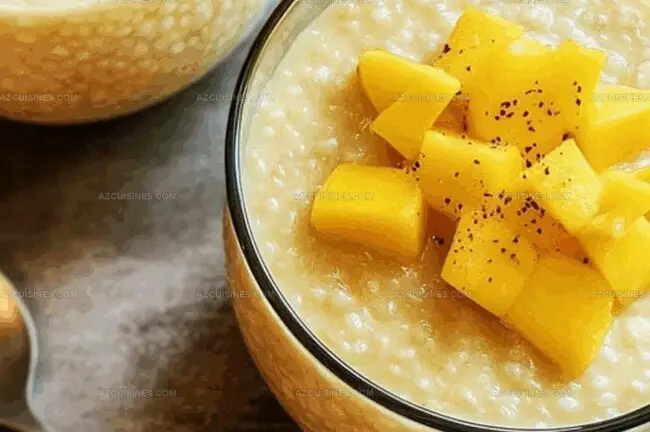Creamy Mango Sago Recipe: A Tropical Sweet Escape
Creamy tropical desserts often surprise with their delightful mango sago combinations that dance between sweet and refreshing.
Sweet mangoes bring golden sunshine into every spoonful of this classic treat.
Silky pearl-like tapioca pearls add delightful texture against smooth fruit puree.
Cool coconut milk creates a dreamy backdrop for the vibrant fruit flavors.
Southeast Asian cuisines have perfected these incredible dessert techniques over generations.
Rich yet light, this delectable dish promises pure indulgence without heavy complexity.
Follow these simple steps to create your own magical tropical experience.
Why Mango Sago Is A Dreamy And Easy Dessert
What You Need To Make Mango Sago
Main Ingredients:Dairy and Sweeteners:Flavor Enhancers:How To Prepare Mango Sago With Ease
Step 1: Boil Water for Sago Pearls
Fill a medium pot with water and heat over high flame until reaching a vigorous boil.
Step 2: Cook Sago Pearls
Add sago pearls to boiling water, stirring periodically to prevent clumping. Cook for 10-12 minutes until pearls become translucent with a tiny white center.
Step 3: Rinse and Cool Sago Pearls
Drain pearls using a fine-mesh strainer, then immediately flush with cold water to halt cooking process.
Step 4: Prepare Mangoes
Peel and dice mangoes into consistent small cubes. Set aside several attractive slices for final decoration.
Step 5: Create Creamy Milk Base
In a mixing bowl, whisk together:Blend until mixture becomes silky smooth.
Step 6: Combine Sago with Milk Mixture
Gently fold cooked sago pearls into the prepared milk blend, ensuring even distribution.
Step 7: Add Mango Chunks
Carefully incorporate diced mango pieces into sago-milk mixture, maintaining pearl structure.
Step 8: Chill Dessert
Refrigerate the mixture for 30-45 minutes to intensify flavors and achieve optimal serving temperature.
Step 9: Whip Cream
Whip heavy cream until soft, billowy peaks develop.
Step 10: Final Blending
Fold whipped cream into chilled mango sago mixture, creating a light and airy texture.
Step 11: Serve and Garnish
Transfer dessert into individual serving glasses. Top with reserved mango slices and serve chilled.
Tips That Make Mango Sago Even Better
Fresh Takes On Mango Sago You Can Try
What Goes Well With Mango Sago
How To Keep Mango Sago Chilled And Fresh
Mango Sago Common Questions Answered
Sago pearls are small, translucent starch balls made from palm stems, commonly used in Asian desserts. You can find them in Asian grocery stores, international food markets, or online specialty food retailers.
Yes, rinsing sago pearls immediately after cooking with cold water stops the cooking process and prevents them from becoming mushy or sticky. This helps maintain their distinct texture and prevents clumping.
Fresh mangoes are recommended for the best flavor and texture, but if fresh mangoes are unavailable, you can use high-quality canned mango chunks. Just ensure they are well-drained and pat them dry before adding to the dessert.
Print
Mango Sago Recipe
- Total Time: 1 hour (including chilling)
- Yield: 2 1x
Description
Silky smooth mango sago dessert whisks tropical sweetness from Southeast Asian cuisine into a creamy paradise. Cool pearl-studded pudding offers refreshing comfort with perfect balance of ripe mangoes and delicate coconut milk, promising pure bliss for dessert enthusiasts.
Ingredients
Fruits and Base:
- 2 ripe mangoes
- 1/2 cup sago pearls
- 1/4 cup water
Dairy and Sweeteners:
- 1 cup coconut milk
- 1/4 cup condensed milk
- 2 tbsp white sugar
Garnish and Additional Ingredients:
- 1/4 cup heavy cream
- 1 pinch salt
- 1 tsp vanilla extract
Instructions
- Prepare a medium pot with water and bring to a rolling boil over high heat.
- Add sago pearls to the boiling water, stirring occasionally to prevent sticking, and cook for 10-12 minutes until translucent with a small white dot in the center.
- Drain sago pearls in a fine-mesh strainer and immediately rinse under cold water to stop cooking process.
- Peel and dice mangoes into uniform small cubes, reserving some slices for garnish.
- In a separate mixing bowl, whisk together coconut milk, condensed milk, white sugar, vanilla extract, and salt until smooth and well combined.
- Gently fold cooked sago pearls into the milk mixture, ensuring even distribution.
- Incorporate diced mango pieces into the sago-milk blend, stirring carefully to maintain pearl integrity.
- Chill the dessert in the refrigerator for 30-45 minutes to enhance flavor melding and achieve a refreshing temperature.
- Whip heavy cream until soft peaks form.
- Before serving, fold whipped cream into the chilled mango sago mixture.
- Garnish with reserved mango slices and serve cold in individual dessert glasses.
Notes
- Sago Perfection: Stir pearls consistently during boiling to prevent clumping and ensure even, translucent cooking.
- Temperature Control: Rinse sago immediately with cold water to halt cooking and maintain delicate pearl texture.
- Milk Mixture Magic: Whisk dairy ingredients thoroughly to create a silky, well-integrated base that enhances overall dessert smoothness.
- Cream Technique: Whip heavy cream just until soft peaks form to maintain light, airy consistency without becoming too stiff.
- Prep Time: 15 minutes
- Cook Time: 12 minutes
- Category: Desserts, Snacks
- Method: Boiling
- Cuisine: Asian
Nutrition
- Serving Size: 2
- Calories: 490
- Sugar: 38 g
- Sodium: 50 mg
- Fat: 23 g
- Saturated Fat: 16 g
- Unsaturated Fat: 7 g
- Trans Fat: 0 g
- Carbohydrates: 66 g
- Fiber: 3 g
- Protein: 4 g
- Cholesterol: 45 mg




Truc Tran (Kris)
Senior Food Editor
Expertise
Home Cooking, Meal Planning, Recipe Development, Baking and Pastry, Food Editor, Cooking-video Maker, Vietnamese Food Evaluation Expert
Education
Truc Tran (Kris), an experienced food writer and editor, is great at exploring and describing global cuisines, from simple street food to fancy dining. In her writing, she skillfully mixes different flavors, cooking methods, and culinary traditions, showing the unique character of various cultures through their food and drinks. On azcuisines.com, Kris highlights her knowledge, especially in Asian cuisine and worldwide traditional dishes.